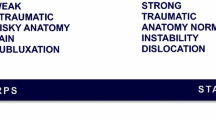Abstract
Purpose
The primary purpose of this paper is to introduce the WARPS/STAID classification system for patellofemoral instability. The secondary purpose is to establish the validity and reliability of the WARPS/STAID classification system.
Methods
Patients (n = 31) with a confirmed diagnosis of patellofemoral instability underwent a thorough knee history and physical examination with 3 raters. The raters graded each component of the WARPS/STAID classification system on a visual analogue scale (VAS). A single Global VAS WARPS/STAID score was graded after all other components of the classification system were completed. Intraclass correlation coefficient (ICC 2, 3) was calculated for each metric of the classification scale and for the Global score. Concurrent validity was assessed by correlating the WARPS/STAID score with the Kujala score. Subjects were assigned to one of three categories (WARPS, STAID, or mixed characteristics) according to the Total WARPS/STAID score to determine the level of agreement between the three raters.
Results
Intraclass correlation coefficient (ICC 2, 3) of the WARPS/STAID classification continuum ranged between 0.73 and 0.91 for the individual metrics of the classification. The ICC (2, 3) for the Global WARPS/STAID score was 0.75. The mean Kujala score (m = 61, SD 18) was significantly correlated with the total WARPS/STAID score (r = 0.387, p < 0.05). The majority of subjects were assigned to either the WARPS or STAID categories.
Conclusion
This study introduced the WARPS/STAID classification system and established both validity and reliability in subjects with patellofemoral instability.
Level of evidence
II.



Similar content being viewed by others
References
Andrish J (2007) Surgical options for patellar stabilization in the skeletally immature patient. Sports Med Arthrosc 15(2):82–88
Arendt EA, Fithian DC, Cohen E (2002) Current concepts of lateral patella dislocation. Clin Sports Med 21(3):499–519
Atkin DM, Fithian DC, Marangi KS, Stone ML, Dobson BE, Mendelsohn C (2000) Characteristics of patients with primary acute lateral patellar dislocation and their recovery within the first 6 months of injury. Am J Sports Med 28(4):472–479
Balcarek P, Ammon J, Frosch S, Walde TA, Schuttrumpf JP, Ferlemann KG, Lill H, Sturmer KM, Frosch KH (2010) Magnetic resonance imaging characteristics of the medial patellofemoral ligament lesion in acute lateral patellar dislocations considering trochlear dysplasia, patella alta, and tibial tuberosity-trochlear groove distance. Arthroscopy 26(7):926–935
Bonett DG (2002) Sample size requirements for testing and estimating coefficient alpha. J Educ Behav Stat 27(4):335–340
Camp CL, Krych AJ, Dahm DL, Levy BA, Stuart MJ (2010) Medial patellofemoral ligament repair for recurrent patellar dislocation. Am J Sports Med 38(11):2248–2254
Dejour H, Walch G, Nove-Josserand L, Guier C (1994) Factors of patellar instability: an anatomic radiographic study. Knee Surg Sports Traumatol Arthrosc 2(1):19–26
Franzone JM, Stein BES, Vitale MA, Ahmad CS (2012) Is there an association between chronicity of patellar instability and patellofemoral cartilage lesions? an arthroscopic assessment of chondral injury. J Knee Surg 25(5):411–416
Fulkerson JP, Shea KP (1990) Disorders of patellofemoral alignment. J Bone Joint Surg 72(A)(9):1424–1429
Kujala UM, Jaakkola LH, Koskinen SK, Taimela S, Hurme M, Nelimarkka O (1993) Scoring of patellofemoral disorders. Arthroscopy 9(2):159–163
McFarland EG, Kim TK, Park HB, Neira CA, Gutierrez MI (2003) The effect of variation in definition on the diagnosis of multidirectional instability of the shoulder. J Bone Joint Surg 85-A(11):2138–2144
McGraw KOWSP (1996) Forming inferences about some intraclass correlation coefficients. Psychol Meth 1:30–46
Nomura E, Inoue M (2005) Second-look arthroscopy of cartilage changes of the patellofemoral joint, especially the patella, following acute and recurrent patellar dislocation. Osteoarthr Cartil 13(11):1029–1036
Panni AS, Cerciello S, Maffulli N, Di Cesare M, Servien E, Neyret P (2011) Patellar shape can be a predisposing factor in patellar instability. Knee Surg Sports Traumatol Arthrosc 19(4):663–670
Paxton EW, Fithian DC, Stone ML, Silva P (2003) The reliability and validity of knee-specific and general health instruments in assessing acute patellar dislocation outcomes. Am J Sports Med 31(4):487–492
Portney LG, Watkins MP (2009) Foundations of clinical research, 3rd edn. Applications to Practice, Prentice Hall
Servien E, Verdonk PC, Neyret P (2007) Tibial tuberosity transfer for episodic patellar dislocation. Sports Med Arthrosc 15(2):61–67
Shrout PE, Fleiss JL (1979) Intraclass correlations: uses in assessing rater reliability. Psychol Bull 86(2):420–428
Sillanpaa P, Mattila VM, Iivonen T, Visuri T, Pihlajamaki H (2008) Incidence and risk factors of acute traumatic primary patellar dislocation. Med Sci Sport Exerc 40(4):606–611
Stefancin JJ, Parker RD (2007) First-time traumatic patellar dislocation: a systematic review. Clin Orthop Relat Res 455:93–101
Streiner DL, Norman GR (2003) Health measurement scales: a practical guide to their development and use, 3rd edn. Oxford University Press, New York
Thomas SC, Matsen FA 3rd (1989) An approach to the repair of avulsion of the glenohumeral ligaments in the management of traumatic anterior glenohumeral instability. J Bone Joint Surg 71(4):506–513
Vollnberg B, Koehlitz T, Jung T, Scheffler S, Hoburg A, Khandker D, Hamm B, Wiener E, Diederichs G (2012) Prevalence of cartilage lesions and early osteoarthritis in patients with patellar dislocation. Eur Radiol 22(11):2347–2356
Conflict of interest
None.
Author information
Authors and Affiliations
Corresponding author
Electronic supplementary material
Below is the link to the electronic supplementary material.
Rights and permissions
About this article
Cite this article
Hiemstra, L.A., Kerslake, S., Lafave, M. et al. Introduction of a classification system for patients with patellofemoral instability (WARPS and STAID). Knee Surg Sports Traumatol Arthrosc 22, 2776–2782 (2014). https://doi.org/10.1007/s00167-013-2477-0
Received:
Accepted:
Published:
Issue Date:
DOI: https://doi.org/10.1007/s00167-013-2477-0




